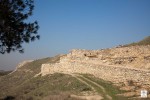Lachish (Lakhish)
(Joshua 10:31) (II Kings 18:13-17) and others – see below
Archaeological site and moshav on border of Judean Hills and Foothills 10 km. southeast of Kiryat Gat.
The ancient city of Lachish has been identified at an adjacent tel. Tel Lakhish is a large tel of a fortified city which dominated the road from the Philistine coast to Jerusalem and Hebron.
History: Excavation finds indicate its earliest habitation was in the 4th century BCE. During the entire Bronze Age it was a fortified city. Mentioned as a royal city in the Tell el Amarna Letters and several times in the Bible. Joshua captured Lachish (Joshua 10:31) and it was included in the Judah tribal allotment (Joshua 15:39). After the division of Kingdoms of Judah and Israel, Rehoboam fortified it along with other cities in the south, apparently against an Egyptian threat (II Chronicles 11:9). Lachish was taken by Sennacherib, King of Assyria, in 701 BCE (II Kings 18:13-17). He commemorated the event by depicting his victories and recording the spoils on a relief that he erected in his palace at Nineveh.
The city was restored and refortified at end of the First Temple Period as ascertained by the contemporary Lachish Letters found in the tel. It was again destroyed, this time by Nebuchadnezzar, King of Babylon, during his first campaign in 598 BCE (II Kings 24:10) and in his second campaign (II Kings 25:1) . Although resettled after the Babylonian Exile (Nehemiah 11:30), it did not regain its past glory. The settlement diminished in the Hellenistic Period and in the Roman Period it moved to an adjacent site (Khirbet Duweir).
Excavations: Early Bronze Age cemetery; Middle Bronze Age fosse and glacis; Late Bronze Age temple; Iron Age gateway and double synthroidnews.net fortifications; large building called the Residency and a Solar Shrine from Persian Period. The most famous finds are the Lachish Letters, 21 ostraca inscribed with ink in a paleo-Hebraic script. The letters deal with local administrative matters and contemporary events. The ostraca are important epigraphic and historic documents of the end of First Temple Period, just before the destruction.
Other finds include pottery, inscriptions and jar-handle seals, one of them having the inscription “(Belonging) to Gedaliah Royal Steward,” apparently referring to Gedaliah son of Ahikam (II Kings 25:22).


